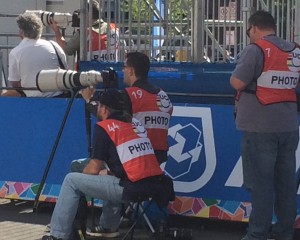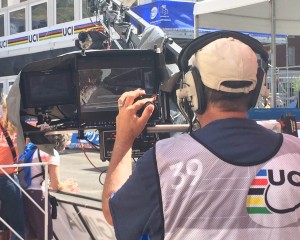Around the Worlds: Behind the Camera
By: Pete Woody
Richmond is always a very photogenic region, with many landmarks and scenes of natural beauty, and on any given day there are amateur and professional photographers snapping shots all over the area. So hosting an international sporting event like the UCI Road World Championships has only served to multiply the number of photographers here, and it seems like everywhere you turn near the race course there is someone taking a picture (there is also no shortage of cow bells, but that is another topic for another day). Fortunately for Sports Backers, we’ve got one of the best photographers around, Jesse Peters, working behind the camera, so we did a quick Q&A to get his perspective on covering an event like this.
SB: What makes a good and/or compelling shot – what are you looking for on the course
JP: I look for background more than anything else – scenery that defines the location of the event. This includes related signage or advertising, spectators, iconic buildings and monuments, and color – fall leaves, spring flowers, building paint, etc.
SB: How does Richmond 2015 compare to some of the other events you’ve shot?
JP: So far, this event is one of the hardest I’ve done. Probably because of the size of the event, and accessibility to competitors. Normally I’m right up in the faces of the racers, and I’m free to be anywhere I want on the course without interfering with the participants or getting in the way of spectators enjoying the event. Worlds is so huge — there are so many photographers with shots they have to get and put up on the wire right away. These folks have top priority and I’m paranoid about getting in their way, so it affects shots I might want to get. In contrast, XTERRA World Championships has all the live video/camera crews and helicopters, etc., but I can go anywhere and shoot anything I want. We all work together for a common goal. The one difference being that in XTERRA events I have to pay special attention to the top pro athletes more than the amateurs, and it’s more important to get the winners at the finish line and out on the course than the background choice (but I try to do both).
SB: What’s the best thing about shooting events like this? And what’s the most challenging thing?
JP: The best thing for me is realizing how out of my element I am. As scary and stressful as it is, at the end of the day I learn so much more about what I’m doing. Sometimes it’s hard to challenge yourself to get better when you do the same events repeatedly, and the scope – and for me, the unfamiliarity – of this event makes me realize that what I might do normally just won’t work in this situation. For instance, I’m having to study my autofocus tracking system all over again because the way time-trialing cyclists move is nothing like folks running in a road race. Sometimes the camera just can’t keep up, or I’ve chosen the wrong setting for a particular shot. It’s very frustrating to miss shots you think are awesome because the focus is on the colorful banner in the background rather than the rider (this is because both subjects are so similar in contrast, the camera can’t decide what to follow if the focus point slips away from the rider – too much information, I know!). So in a way, this is the best and the most challenging part of events like this – you fail much more than usual, but you learn how to avoid it and get better in the long run.
I also enjoy meeting the other photographers from around the world and watching what they do to get the stuff they need. We can be side-by-side and both photos look completely different. It’s fun.
 SB: Lastly, how many photos will you end up taking at an event like this?
SB: Lastly, how many photos will you end up taking at an event like this?
JP: I took 1600 on Tuesday, but 300 or so aren’t usable because of blur or composition problems. I’ll probably take twice that Saturday and Sunday, but less today. I’d guess over the five days I’m shooting maybe 6500 usable shots, not counting the Conquer the Cobbles event. I take so many because one rider might have a kit or bike that is more colorful than another in a particular location, so I’ll stand there and shoot three or four riders and just choose the best colors and not bother editing more than two shots out of 24. I get about a 10 percent ‘good shot’ ratio (1500 shots =150 good shots), but I’m really particular in my selections.